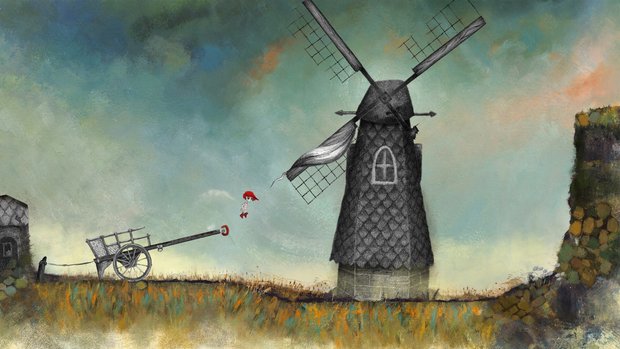Unleaving review

- 0 Comments
Come for the gorgeous artwork and stay for a few hours of fun if overly esoteric puzzle-platforming gameplay
I don’t much care for poetry, and most uses of allegory annoy me. That’s not a critique, but rather my bias I carried with me as I played Unleaving, the first game by indie developer orangutan matter. But despite my predilection to avoid artsy stuff, I couldn’t help but be drawn in by how gorgeous it looked. A puzzle-platformer in the vein of Limbo, this short and relatively easy adventure, while clumsily struggling with pathos, should please fans of the genre with its stunning art style and eclectic puzzles.
Normally I would begin by introducing the protagonist, but the main character of Unleaving is the art. Indeed, before the game starts you are informed that you are about to see thousands of pencil, graphite, and acrylic drawings. Every backdrop evokes the tranquility of watching The Joy of Painting; even the presence of a vicious dog and the constant risk of death are not enough to break that spell. Particularly mesmerizing is the use of stop motion to make the few cutscenes come to life, with paintings evolving before your eyes. Graphite illustrations—particularly a butterfly that follows you—dance across the landscape, and to top things off, the game will artfully zoom in or out during gameplay to emphasize empty vastness or claustrophobia. It’s truly a mesmerizing experience.

The audio, while not nearly as impressive, succeeds equally at setting a mood. There’s very little music, allowing the ambient sounds of nature to pour through. From gentle breezes to the thump of footsteps to the mechanical creak of windmills, the soundtrack of real life carries on in the background, allowing you to focus on the task at hand.
You control a red-headed child who starts out sitting on a cliff and presumably pondering life’s meaning when a butterfly dances by. As the butterfly dances to the right, guiding you that way, the heading “AWAKE” with the question “Why are you here?” displays prominently on the screen. Using a gamepad or keyboard, you move in that direction as the game gives you a simple tutorial on jumping and pulling objects. Other than moving (or swinging) left and right, those are the only two actions necessary. The protagonist, not named, is a pencil drawing who remains static outside of their swinging arms and legs.
The action begins simply as you learn how to jump to reach ledges or over small chasms. The first real puzzle entails finding your way up a tall cliff that has a conveniently placed windmill beside it. One of the sails has a piece of cloth tightly dangling from it with some farming equipment adjacent that acts as a fulcrum and level. Timing it just right, you must run up the lever and leap to catch the cloth, then jump across to the high ledge as the sail reaches its peak.
Thankfully, Unleaving’s puzzles grow increasingly more creative as things move along. A vicious canine stalks you for a while, similarly to the giant spider in Limbo. I didn’t find it particularly scary, in part because it’s not a GIANT SPIDER, but mostly due to the gentle music not amplifying the danger. Still, I succumbed to the creature probably a dozen times across several puzzles that see you gradually slow it down before your eventual victory. The solutions to these encounters, involving another windmill but also a rope and a well, are not immediately obvious at first glance, but after some trial and error the eureka moment hits to much satisfaction.

Death occurs frequently, less often by hungry animal and more so by drowning in the various bodies of water when you mistime jumps. These demises are neither anxiety-provoking nor frustrating; dying is quick, minimally graphic, and you are revived to the puzzle’s outset. I kicked the bucket probably twenty to thirty times while playing but never felt the game was unfair with me. A subtle hint system is available; should you ask for help with a puzzle, it will simply show a small graphic of an object you have come across, essentially guiding you to that area without explicitly telling you what to do.
Perhaps Unleaving’s greatest achievement is that few puzzles are repeated, which is surprising considering the limited mechanics. One long sequence involves mastering the use of magnets while jumping sideways or upside down. Another delightful section sees you trying to save a symbolic version of yourself, who is stuck behind a cracking mirror. It’s hard to even describe the puzzle due to its surrealism, but it’s nevertheless an engaging and captivating moment. Speaking of mirrors, my favorite section sees you joined by your mirror image on the bottom of the screen. It mimics your every move, but its presence requires you to be extra careful while jumping to ensure your shadow doesn’t meet its demise on the dangers below, while also using your shadow to your advantage to solve puzzles above.
Unfortunately, at least for me, the puzzles are regularly interrupted by the skeleton of a story highlighted by musings with the depth of a motivational poster. After being asked why you’re here, you stroll along before being told “You are home,” and then later “but you are lost.” The allegory of existential crisis and self-acceptance could have been moving had the commentary stopped there, as the art and gameplay themselves regularly drop subtle hints as to the purpose of the journey. But the game doesn’t trust you to interpret for yourself, instead jamming down its message without any additional clarity.
The second chapter is titled “DESCENT,” followed by the game asking “How do you begin?” As you descend a well, you’re asked “What do you search for?” followed by the word “ABSURD.” Perhaps the most obnoxious reflection was the game telling me “You yearn for a candle to burn beyond,” and then shortly after commenting “but this candle is dim.” I spent the whole time distracted from the wonderful art and attractive puzzles by the feeling that I was watching an interpretive dance while the narrator shouted what I was supposed to feel. Perhaps others will enjoy this sort of poetic signposting more, but as I said at the outset, I am not the target audience for this sort of thing.
Final Verdict
The whole experience took me a little over a brisk three hours, the perfect amount given the game’s limited scope. I wish I could say the ending was an emotionally sweeping culmination of art and puzzle design, but for me it was simply the end of the puzzles. The finale wasn’t particularly fulfilling, but by the time I got there, I had largely lost interest in what it was meant to be about. There’s nothing wrong with that per se. If you like light platformers like Limbo, you’re sure to enjoy Unleaving, which offers jaw-dropping visuals and enough creative puzzles to keep you entertained for a few hours. The heavy-handed story is awkward and forced, leaving the experience devoid of the pathos that could have made it a masterpiece; still, the rest is strong enough to make the experience worth your while.
Hot take
If you enjoy side-scrolling puzzle-platformers, Unleaving is a fun afternoon snack. The esoteric narrative is too clumsy for its own good, but the team at orangutan matter is incredibly talented, and they’ve earned their stripes when it comes to gameplay and design.
Pros
- Magnificent hand-drawn and painted visuals with stop motion cutscenes
- Creative and engaging platform puzzles that never feel repetitive
- Ambient sounds enhance the already tranquil atmosphere
Cons
- Narrative unnecessarily stunts the mood with in-your-face allegory without any emotional payoff
Beau played Unleaving on PC using a review code provided by the game's publisher.











0 Comments
Want to join the discussion? Leave a comment as guest, sign in or register.
Leave a comment